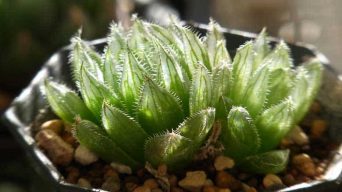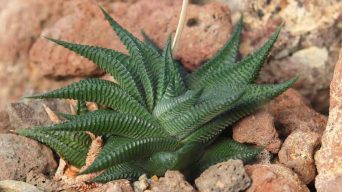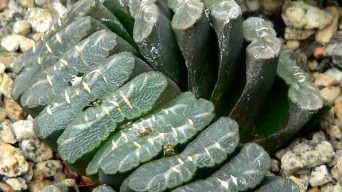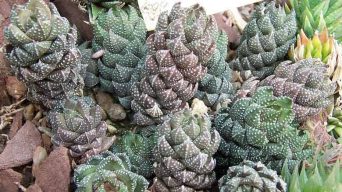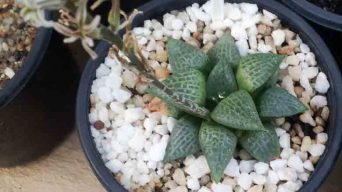Key Takeaways
- Provide bright, indirect sunlight. Haworthias prefer some ambient sunlight, but harsh direct rays can burn the leaves. East or west-facing windows are ideal.
- Use well-draining soil and avoid overwatering. Soil should be porous and drain readily. Allow soil to dry out between waterings to prevent deadly root rot.
- Give moderate fertilizer. Haworthias don’t need much nutrition. Use a balanced dilute fertilizer monthly during the growing season.
- Repot when roots fill the container. Gently loosen roots when upsizing pots. Match pot size to the root system.
- Propagate easily from offsets and leaf cuttings. Carefully detach and replant offsets from the mother plant. Root single leaves in the soil to grow new rosettes.
Haworthia plants have become increasingly popular houseplants, adorning windowsills and desks in homes and offices worldwide.
With their unique shapes, textured leaves, and relatively compact size, it’s easy to see why plant parents so widely enjoy these succulents.
However, Haworthia plants require proper maintenance and care practices to thrive like any living thing under our care.
The good news is that these plants are resilient if their basic needs are met!
In this complete guide on how to care for Haworthia succulent plants, we’ll cover everything you need to know to keep your Haworthias healthy and happy.
We’ll discuss their ideal growing conditions, watering techniques, seasonal adjustments, and propagation methods.
Whether you’re new to the world of succulents or looking to expand your Haworthia collection, you’ll find plenty of helpful information here.
With the proper care regimen, you can enjoy your Haworthia plant for many years.
Their interesting forms and textures make them a delight to have around the house.
Let’s get started!
Understanding Haworthia Plants
Haworthia species is a large genus of small succulent plants within the Aloe family, native to southern Africa.
There are over 60 official species, though some are believed to be hybrids.
Haworthia succulents are appreciated for their unique appearance, often described as alien-looking.
Their triangular, thick, fleshy leaves grow in a rosette shape and come in various hues, including green, red, and brown.
Some varieties have translucent ‘window’ areas on the leaves.
In their native habitat, Haworthias thrive in arid regions and rocky terrain.
They tend to grow beneath shrubs or other larger plants, benefiting from the shade and shelter.
Haworthias have adapted to survive drought conditions in the wild, storing water in their thick leaves.
However, they cannot tolerate sitting in wet soil, so excellent drainage is crucial.
With the proper care, they can adapt well to indoor environments.
Let’s look at what these succulents need to truly flourish.
Essential Haworthia Growing Conditions
To keep your Haworthia houseplants healthy, it’s important to recreate the right conditions for them to thrive.
Here are the key factors to get right:
Light Requirements
Haworthias prefer bright indirect light.
They should be placed near a sunny window where they can benefit from ambient light without harsh direct rays shining on the leaves.
Direct sunlight can scorch the leaves, causing sunburn or discoloration.
To provide bright indirect sunlight, east or west-facing windows are ideal.
If you only have a south-facing window, diffuse the light with a sheer curtain.
Temperature and Humidity
The ideal temperature range for Haworthia plants is about 60-80°F during the day and around 50-55°F at night.
They can tolerate higher and lower temperatures but may grow more slowly.
Ensure the plants aren’t exposed to freezing temperatures or frost. Provide moderate humidity, around 40-50%.
Haworthias don’t require high humidity but shouldn’t be kept in excessively dry air.
Group plants together or use a pebble tray to boost ambient moisture.
Soil Selection and Potting
Haworthias need a very well-draining succulent or cactus potting soil mix.
Look for a blend containing sand, perlite, gravel, or pumice for airflow and drainage.
Proper soil aeration prevents rot and allows the roots to receive oxygen.
Choose a pot with drainage holes using a terracotta or plastic container.
Ensure the pot isn’t too large for the plant’s root system.
Watering Practices
When it comes to watering Haworthia plants, the key is moderation.
As drought-resistant succulents, they don’t need constant moisture, but they can’t go for long periods without any water, either.
Watering Frequency
During the growing period in spring and summer, allow the soil to dry out between waterings fully, then soak the soil thoroughly.
In the winter, you can water even less frequently, waiting until the soil is bone dry before watering.
The time between waterings can range from 1-2 weeks in summer to 3-4 weeks in winter, depending on conditions.
Always check soil dryness instead of sticking to a fixed schedule.
Watering Techniques
Water at the base of the plant, not on the leaves. Pour water slowly until it runs from the drainage holes at the bottom.
After watering, tip the pot to drain excess water so the roots don’t sit in moisture.
Never allow pots to collect water in a drain tray.
Avoiding Overwatering and Root Rot
Overwatering is the most common and often lethal mistake for Haworthia growers.
Too much moisture causes the roots to rot and die.
Check for soft, discolored leaves as an early sign of overwatering.
Allow the soil to dry out completely before the next watering to prevent further issues.
Good airflow around the plants also helps reduce moisture buildup.
Pruning, Maintenance, and Seasonal Care
Proper pruning, routine maintenance, and seasonal adjustments are vital for keeping Haworthia plants looking their best.
Pruning and Grooming
Trim off any dead, yellowing, or damaged leaves using sterilized shears.
This encourages new growth. Also, remove the tall flower stalks after blooming finishes.
Selectively prune some larger outer leaves to keep the Haworthia succulent plant compact and create a desired shape.
Seasonal Care Adjustments
In the spring and summer growing season, Haworthias can be watered more frequently.
Provide bright light without direct sun exposure. Move plants outdoors if temperatures remain moderate.
In winter, allow them to enter a period of dormancy with reduced watering.
Keep plants away from drafts, heat vents, and cold windows.
If your climate experiences hard frosts, keep Haworthias indoors.
With some attentive care adjustments, you can help your Haworthias thrive year-round!
Don’t hesitate to adapt your practices as the seasons change. Observing the plants is the best way to determine their needs.
Proper Nutrition
While Haworthias don’t require heavy feeding, proper nutrition can promote healthy growth.
Understanding Nutrient Needs
Haworthias have relatively minimal nutrient requirements. Occasional dilute fertilizer during the growing months is sufficient.
Look for balanced succulent fertilizers that provide macronutrients like nitrogen, phosphorus, and potassium in smaller proportions.
Avoid overfeeding, as excess salts can burn the roots.
Applying Fertilizers
Use a diluted liquid fertilizer at half-strength. Apply monthly or biweekly in the spring through early fall.
Always follow package directions. Drench the soil, avoiding contact with the leaves.
In winter, discontinue fertilizer as plants are dormant.
Flushing the soil every few months prevents buildup from accumulated salts.
Adequate nutrients ensure your Haworthias look their best!
The key is not to overdo it with fertilizer for these plants.
A little goes a long way when used correctly.
Pay attention to how your plants respond and adjust your feeding as needed.
Container and Repotting
Choosing the right pot and knowing when to repot are essential to maintaining healthy roots.
Choosing the Right Container
Always select containers with drainage holes to prevent moisture buildup. Porous terracotta pots allow more evaporation but can dry out faster.
Plastic pots retain moisture longer.
Match pot size to the succulent plant’s roots, allowing some room for growth. Avoid oversized pots, as wet soil can cause root rot.
Repotting Guidelines
Repot when the roots fill the current container. Signs include bulging from drainage holes or slowed growth.
Use a pot just one size up with fresh soil. Gently loosen the roots, but don’t break the root ball.
Settle the succulent plant at its original soil depth.
After repotting, avoid fertilizing and reduce watering until established. Repot in spring before the growing period.
Your Haworthias will continue growing strongly with attentive potting practices in their new homes.
Their shallow root systems don’t require frequent repotting, but occasional upsizing keeps them healthy.
Dealing with Common Issues
Like all plants, Haworthias can encounter various problems with pests, diseases, or environmental factors.
Identifying and addressing any issues promptly helps maintain your plants’ health.
Pests
Mealybugs, spider mites, and scale insects are common pests that affect Haworthias.
Look for small bugs, speckled markings, or sticky residue on leaves.
Treat with horticultural oil or insecticidal soap sprays.
You can also wipe pests away gently with a cotton swab dipped in alcohol.
Prevent infestations by keeping plants healthy and isolated from affected plants.
Diseases
Overwatering can lead to potentially fatal root or stem rot. Signs include softened, discolored leaves and stunted growth.
Improve drainage and water less frequently.
Discard diseased plants to prevent spreading.
Bacteria and fungi can also cause leaf spot diseases.
Prune affected leaves and apply copper fungicide if needed.
You can quickly identify and resolve any pest or disease problems to maintain thriving Haworthia plants.
Keep your eyes peeled for early signs of issues and take prompt action. With attentive care, your plants will continue to delight you with their unique charm.
Propagation Techniques
One of the joys of growing Haworthia plants is producing new plants from the original.
Haworthias propagate easily through offsets and leaf cuttings.
Offsets Division
Mature Haworthias produce offshoots, called pups or offsets, from the main stem.
Carefully separate these with a sterile knife when they are 1/3 to 1/2 the mother plant size.
Allow offsets to dry for 2-3 days before replanting in well-draining soil. Water sparingly until established.
Leaf Cuttings
To propagate Haworthia plants, select healthy leaves and carefully cut them near the stem.
Allow the cut end to callus over for a few days.
Place the leaf on well-draining soil.
Roots and new rosettes should emerge in a few weeks.
Once the new plant is established, transplant it into its container.
Propagating provides an endless supply of new Haworthia succulent plants!
It’s a rewarding way to expand your collection.
Offsets and leaf cuttings are relatively easy methods that require minimal equipment and expertise.
Final Thoughts
With their uniquely shaped and textured leaves in a pleasing rosette form, it’s no wonder Haworthia plants are so prized by succulent lovers.
Caring for these delightful plants is straightforward when you understand their needs for bright, indirect light, porous and well-draining soil, and moderate watering.
Avoid overwatering, which can lead to rot and death of these succulents.
Give them the right conditions, and your Haworthias will thrive for years of enjoyment.
We’ve covered the essentials of Haworthia plant care, including propagation methods, seasonal adjustments, container potting, and troubleshooting common issues.
Don’t let their exotic appearance fool you – Haworthias are adaptable plants that can flourish indoors or outdoors when their requirements are met.
With this complete guide, new and experienced growers can confidently provide their Haworthia plants with exceptional care.
Enjoy learning about these fascinating succulents, and have fun expanding your collection!
The satisfaction of nurturing these rosette beauties is well worth the effort.


